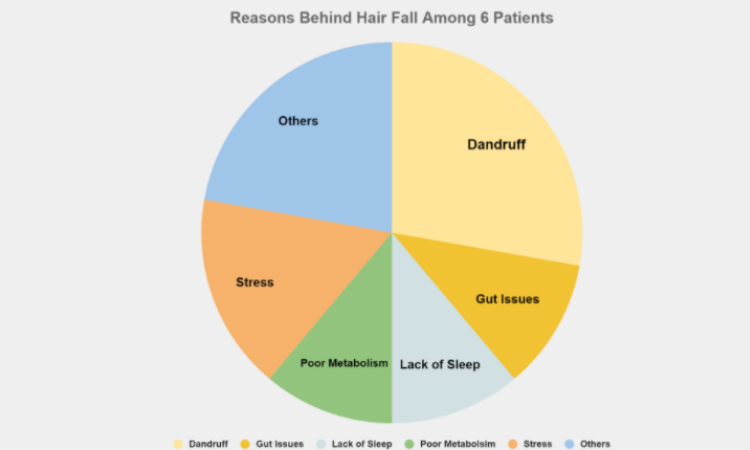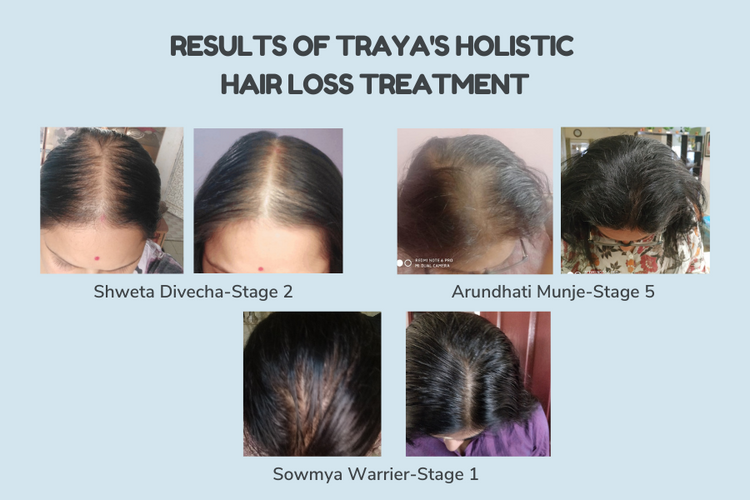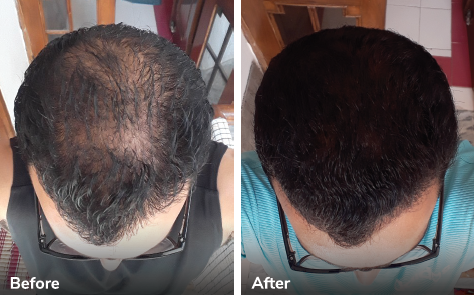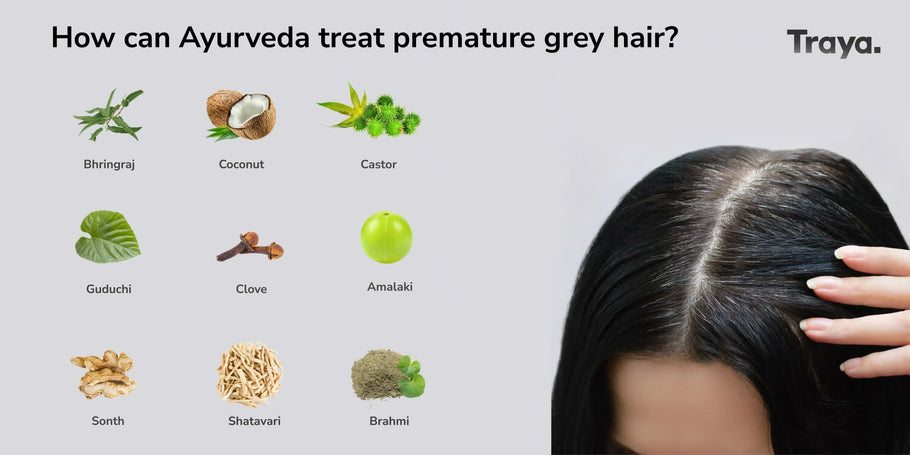Abstract:
Female Pattern Hair Loss (FPHL) has emerged as the preferred term for androgenic alopecia (AGA) in women. This is the most common form of hair fall in women. According to modern science, hair loss occurs due to poor follicle strength caused by the effects of the androgen (sex hormone) called dihydrotestosterone (DHT) and so dermatological treatments focus towards reducing the DHT levels in the body. Ayurvedic studies reveal that hair loss is caused due to internal pitta (heat) imbalance and so Ayurvedic therapies to manage hair loss are targeted towards improving and rejuvenating the internal health with the help of herbs and essential oils. Several other studies have also shown the potential associations between AGA or female pattern hair loss and nutritional deficiencies or an imbalance diet. The objective of this study is to share insights of using a holistic approach - Ayurveda, Nutrition, and Dermatology for managing female pattern hair loss between the stages 1-4 in the age group of 20-60. It was observed that the levels of internal health conditions were improved like metabolism , gut health, scalp health as well as sleep and stress. This progress was self-reported while the hair density and regrowth was observed by comparing scalp images during the course of the treatment which was provided by the patients themselves.
Keywords: Female pattern hair loss, androgenic alopecia, Ayurveda, Nutrition, Dermatology.
Introduction:
Over 60% of the Indian Female population is affected by Female pattern hair loss (FPHL). The initial symptoms for this condition develop right from the teen years and lead to progressive hair loss that contains a characteristic pattern with miniaturization of the hair follicles and thinning of the hair, eventually leading to scalp visibility in the frontal and central regions of the scalp. This hair loss has 7 stages where after the 5th stage of hair loss, the follicles begin to die and cannot be further stimulated. At these advanced stages between 6-7, a hair transplant is the best available solution. For the initial stages of hair loss, there are a number of treatments that are available but fail to give long term results since they are only one dimensional. Therefore, a combined solution with the help of Ayurveda, Dermatology and Nutrition serves as the most suitable way to manage the internal and external triggers that cause hair loss to obtain long term results as also effective hair regrowth.
Methodology:
|
CRITERIA |
CONTENT |
|
Sample Size |
6 participants (All Women) |
|
Age Group |
Between 20-60 |
|
Stage of Hair Loss |
Stage 1-5 |
|
Type of Hair Loss |
Androgenic Alopecia (AGA)/ Female Pattern Hair Loss |
|
Treatment |
Ayurveda, Nutrition, Dermatology |
|
Duration of Treatment |
7-8 months |
|
Location |
Pan India |
Results:
-
Pie Chart depicting the various Hair fall Triggers Among the 6 Patients

Interpretation: It was found that the 6 female patients suffering from Androgenic Alopecia, were also facing other similar issues that were triggering their hair fall. Dandruff was the most common seen among all 6 individuals followed by stress, lack of sleep, poor metabolism with low energy levels and gut issues which also included irregular bowel movements to some extent. Other health conditions among these women included Vitamin deficiency, Arthritis, Iron & Hemoglobin deficiency and PCOS.
-
Treatment Components:
|
To boost absorption and metabolism, which helps improve energy levels |
|
|
To nourish hair follicles naturally |
|
|
To improve gut health and digestion. |
|
|
To improve sleep quality and relieve stress |
|
|
To keep scalp healthy and has a relaxing effect |
|
|
To get rid of heavy dandruff, soothe irritation and prevent recurrence |
|
|
To stimulate hair follicles. It increase growth phases and makes hair thicker |
|
|
For vitamin deficiency and naturally reducing damage from dihydrotestosterone (DHT) |
|
|
To regenerate hair follicles, promoting hair growth by boosting the blood circulation to the hair cells which allows them to heal and stop hair loss |
|
|
To stimulate hair follicles, restores root health, and nourishes the scalp. |
|
|
To put the body in a healing state to enhance the results |
-
Treatment Outcomes
- Self-Reported Progress

Interpretation: The results obtained from the self- reported progress showed common health improvements among the patients. Hair fall was controlled and hair regrowth was observed in all 6 patients. Stress levels were reduced in most of these patients followed by improvements in their digestion and energy levels. Improved gut health along with bowel movements was observed in these patients to a certain extent.
-
Comparison of Scalp Images:
The below scalp images were obtained from patients before starting the treatment and later on completing 7-8 months of the treatment.


Interpretation: On comparing the scalp images during the course of the treatment, it was observed that before the recommended treatment plan (images on the left), all patients had hair thinning and a greater scalp visibility. After being on the Traya Treatment Plan for an approximate of 7-8 months (images on the right), the hair density and texture has improved along with decreased scalp visibility.
Understanding Female Pattern Hair Loss: The Root Cause Approach
Hair thinning in women isn’t the same as in men. It often develops gradually, showing up as a widening parting, reduced hair density, or overall volume loss. The causes can range from hormonal changes and nutritional deficiencies to stress and underlying health conditions like thyroid imbalances.
Traya’s approach goes beyond surface-level solutions. It works by identifying and treating the root cause through a personalized, comprehensive treatment plan that includes:
-
Ayurvedic Assessment: Identifies body imbalances (pitta, vata) that may be affecting hair health.
-
Dermatologist-Guided Prescriptions: Targeted medications, only if necessary, to support regrowth.
-
Nutrition Support: Gut repair supplements, vitamins, and diet recommendations to strengthen hair from within.
Traya understands that treatment is not just about stopping hair fall but actively restoring hair health. Real cases show that consistency with this plan leads to visible improvements over time.
Women Are Seeing Real Results with Traya
Hair thinning in women is often overlooked in clinical studies, which typically focus on male pattern baldness. However, Traya has successfully helped thousands of women dealing with pattern thinning, postpartum hair loss, and chronic shedding through its personalized, root-cause approach.
In a Clinical study of 1,200 users (ages 21–40), Traya’s treatment showed:
-
Three times better hair density compared to Minoxidil alone
-
Visible improvements starting from month three
-
Higher adherence rates, thanks to a personalized plan targeting internal imbalances
Dr. Shefali Batra, a leading expert in hair health, explains:
"Women’s hair loss is complex—it’s never just a scalp problem. That’s why Traya’s multi-system approach is so effective."
By addressing nutrition, hormonal imbalances, and scalp health together, Traya provides a comprehensive solution tailored to each individual.
What is Included in a Traya Plan
Every Traya treatment is customized based on individual needs, but most women’s plans follow a holistic structure targeting the internal and external factors contributing to hair thinning. Here’s what a typical Traya plan looks like:
|
Type |
Sample Products |
Why It Was Prescribed |
|
Ayurveda |
Shatavari + Brahmi |
Balances hormones, reduces stress, and supports detoxification |
|
Dermatology |
Mild Minoxidil + Anti-fungal Lotion |
Stimulates hair growth while treating scalp inflammation |
|
Nutrition |
Iron, Vitamin D3, Biotin, Gut Health Support |
Corrects deficiencies and improves nutrient absorption for hair health |
|
Lifestyle |
Sleep cycle support + Scalp massage |
Regulates overall health and enhances scalp circulation |
Traya’s 3 fold approach ensures that hair thinning is tackled at its root cause, making it an effective solution for long-term hair regrowth and strength.
Conclusion
Although these 6 women were suffering from genetic female pattern hair loss, they each had internal triggers that were aggravating their hair loss condition. By treating these triggers and simultaneously working on stimulating the hair follicles they were able to see visible hair growth along with health improvements. It is also important to note that these individuals saw successful results because they were still in the early and manageable stages of hair loss. These individuals are now on minimal maintenance to ensure that their hair volume and density stays normal. The combination therapy of Ayurveda, Nutrition and Dermatology help fix the root cause of hair fall and eventually hair regrowth.
*Note:
These treatments were successful only because these customers followed the plan consistently for the recommended duration.






